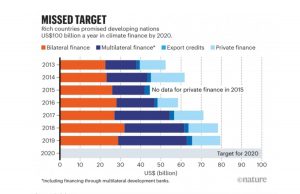27th edition of Conference of Parties (COP27)
What’s the news?
- Recently, the 27th session of the Conference of the Parties (COP27) was held in Sharm-El-Sheik in Egypt from November 6-18.
- The 27th Conference of the Parties to the United Nations Framework Convention on Climate Change – COP27 builds on the outcomes of COP26 to deliver action on an array of issues critical to tackling the climate emergency – from urgently reducing greenhouse gas emissions, building resilience, and adapting to the inevitable impacts of climate change, to delivering on the commitments to finance climate action in developing countries.
- COP27 seeks renewed solidarity between countries, to deliver on the landmark Paris Agreement, for people and the planet.
Goals and vision for COP27
- Mitigation
- Mitigation aims to keep global temperatures below at least the 2 degree Celsius threshold.
- NDCs are a crucial part of the Paris Accord. They are essentially domestic action plans on climate mitigation that each party prepares, communicates and maintains, post 2020.
- The data show that the current pledges made would reduce CO2 emissions by just 0.5 gigatonnes–less than 1% of what is predicted for 2030.
- To meet the COP goal, countries will have to increase their unconditional and conditional (needing external assistance) NDCs by 5% and 10%, respectively. If this doesn’t happen, the report’s findings say that global temperatures will increase by 2.7 degrees Celsius by 2100.
![]()
2. Adaptation
- Extreme weather events from heat waves, floods, forest fires have become an everyday reality of today’s world. According to a report by the Centre for Science and Environment, India saw extreme weather events on 88% of the days in the first nine months of this year. These disasters, which have become more frequent and far more intense than they were earlier, killed 2,755 people and destroyed acres of crops and thousands of homes.
- The Global Goal on Adaptation was one of the significant outcomes of COP26.
- At COP26, over $350 million was pledged to the Adaptation Fund, and over $600 million was pledged to the Least Developed Countries Fund, to help those nations face the impacts of climate change.
- The evidence clearly shows that countries that have a far smaller carbon footprint are facing the worst consequences of climate change.
- Eg: In Pakistan, the monsoon floods submerged a third of the country and displaced over 33 million people.
- According to the Global Climate Risk Index published by the Berlin-based, non-profit analysis group Germanwatch, Mozambique, South Sudan and India were the countries most affected by extreme weather events in 2019. Mozambique contributes just 0.06% of global emissions.
- India is one of the world’s third-biggest carbon emitters and one of the nations most impacted by climate change. Last year, Prime Minister Narendra Modi said India would reach net-zero status by 2070. Until then, however, India continues to burn coal, with policymakers arguing that, “fossil fuels power [India’s] economy that helps lift millions out of abject poverty.”
- This year India is demanding that nations that are already industrialized and developed should carry the weight of climate change financing and mitigation.
- Thus, the efforts to fight Climate change must also be backed with political will.
3. Finance
- A key responsibility that developed countries were assigned in the Paris Accord – the goal that the conference and its members are working to achieve – is that they should “take the lead in providing financial assistance to countries that are less endowed and more vulnerable.”
- At the 2009 COP15 summit, developed nations collectively committed to pledging $100 billion per year by 2020, to aid developing countries manage climate change. The promise was made official at COP16, and then extended until 2025 during COP21.
- But this has not been happening. In 2018, developed nations raised $78 billion for developing nations. In 2019, that number increased a little to $80 billion.

- Without adequate funding, any country, but especially those that are still developing, will not be able to invest in the infrastructure necessary to adapt and protect themselves while also battling the worsening impacts of climate change.
4. Collaboration
- The last segment of the COP27 mission is to get Parties to collaborate. The mission calls on governments, civil society and the private sector to, “work in tandem, to transform the way in which we interact with our planet.”
- Despite doubling down on this commitment at COPs over the years, global consumption of the most polluting fossil fuel, coal, continues to rise.
- According to the BP Statistical Review of World Energy 2022, coal consumption rates majorly increased in 2021. Eg: Following a dip in 2020 due to the pandemic, globally, coal consumption shot up in 2021.
- Non-OECD countries’ coal consumption grew by 6.3%, a new record. They make up 81.5% of the world’s coal consumption.
- India especially has seen a growth in coal consumption and is currently the world’s third-largest emitter. At COP26, a pledge was made that India would achieve net-zero status by 2070.
- A report by the Global Energy Monitor (GEM), reveals that India has 99 new coal projects in line, with the production of 427 million tonnes per year (mtpa).
- Besides the 2070 goal, India’s NCD target aims to cut 1 billion tonnes of carbon emissions by 2030 and reduce emissions’ intensity by 45%.
- The advancement of partnership and collaboration will help deliver our four goals and ensure the world is adopting a more resilient, and sustainable economic model where humans are at the center of climate talks.
Tag:CoP27, GS 3: Environment
Subscribe
Login
0 Comments
